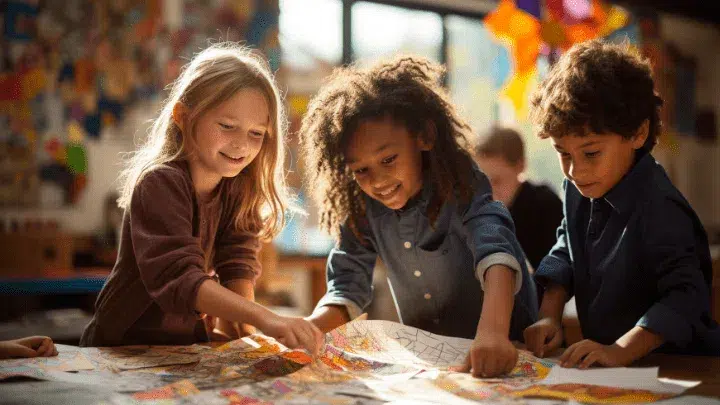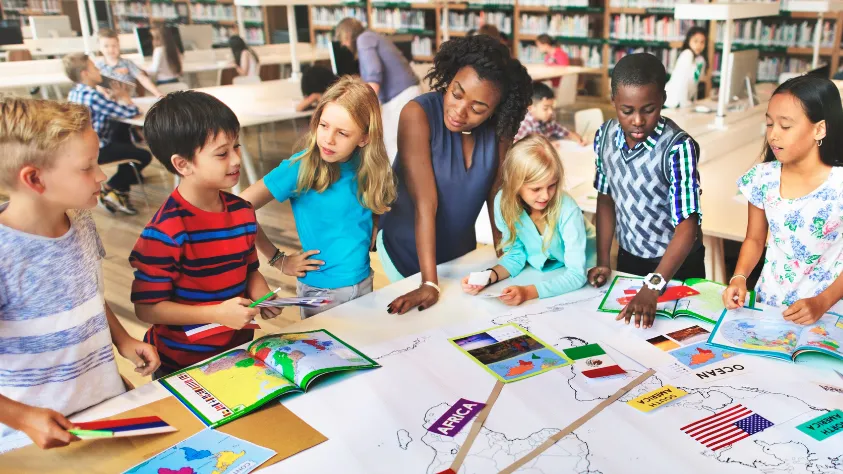
The secrets of active learning

The origins of active learning
The concept of active pedagogy dates back to the 19th century. Pedagogues such as Friedrich Fröbel, John Dewey, Maria Montessori and Johann Heinrich Pestalozzi were pioneers in this field.
The big idea that unites them ? Quite simply, “learning by doing”! It’s not a new idea, since Confucius once said “I hear and I forget, I see and I remember, I do and I understand”.
Forget the traditional model where a teacher pours knowledge onto passive students. Instead, imagine a classroom where students are the main actors in their learning…
✏ Note: Active learning is not new. It draws on the ideas of several great pedagogues and is based on the idea of making the student the main actor in his or her learning. 🎓
What is active learning ?
- The learner at the center: in active pedagogy, the student is not a mere spectator, but a key player in the learning process. Rather than simply listening to a teacher, they ask questions, take part in discussions and debates, and engage in activities that help them build their own knowledge.
- Experience above all: the famous saying “learning by doing” takes on its full meaning here. The active learning approach considers experience to be one of the best ways to learn. Rather than sitting and listening to a lecture, students discover for themselves through practical exercises, group projects or even field studies.
- Interactivity: in active learning, interaction is central. This can take the form of class discussions, group work, or even feedback and constructive criticism between students and teachers. Interactivity not only serves to maintain attention, it also encourages the development of social skills and critical thinking.
💡 Babaoo’Tip:
To apply active pedagogy at home, don’t wait until you understand everything in minute detail. Start small. Experiment with a simple activity like asking children to create a story around a concept they’re learning.
Some examples of active learning
- In a language class: instead of just grammar exercises, students take part in tandem conversations, each playing the role of a tourist in a country whose language they are learning. It’s a practical way of practicing language skills in real time.
- In a geography class: rather than learning countries by heart, students divide into small groups and are given a country to study. Each group then creates a short interactive presentation with maps, photos and facts about the culture, language, currency, borders, etc., to share their findings with the class.
- In a literature class (for older students): instead of focusing solely on individual readings, students divide into small groups to analyze a text and present their findings to the class. This interaction not only invites reflection, but also allows students to learn from the perspective of others.
Advantages and limitations of active learning
Advantages
- Engagement: students are more involved and more willing to learn.
- Deep understanding: facilitates long-term comprehension and retention.
- Social skills: reinforces skills such as collaboration and communication.
Limitations
- Time: this can quickly become time-consuming for the teacher.
- Inequalities: not all students adapt at the same pace.
- Resources: often requires more materials or specific spaces.
✏ Note: Active learning is a powerful tool that greatly enriches the learning experience. While having its own specificities and use cases, it paves the way for more engaged participation and deeper learning. The trick lies in flexibility: knowing when and how to integrate this method into your teaching arsenal.
Some preconceived ideas about active learning
- “It’s for alternative schools only”
False. Many traditional schools incorporate these methods. - “It’s too free, students do what they want”
Not really. Structure and guidance are always present, and even indispensable for the smooth running of the class. - “It’s less rigorous”
Quite the contrary: it often requires more preparation and follow-up on the part of the teacher.
Why is change scary?
Change often arouses anxiety because it calls into question what we know and master. In education, this feeling is amplified by the responsibility we feel for the well-being and development of our children.
Fear often stems from uncertainty: “Will this new method be effective? Will it create more work for me as a teacher? Will the students adapt?”
Understanding that active pedagogy, like any other tool, has its place and its moments of application can help alleviate this fear. It’s not necessary (or desirable) to revolutionize your entire way of teaching overnight. It’s possible to start gently, for example by letting students choose the recitation they’re going to learn, or the text for the next dictation. Then, little by little, make them more involved in their own learning.

The Babaoo recap!
Although it can sometimes scare off some teachers in terms of the time and resources required, active pedagogy has many advantages, such as increased student engagement and better retention of lessons. Active pedagogy makes students actors in their own education, and emphasizes experiential learning, collaboration and interaction.
You may also be interested in these articles


